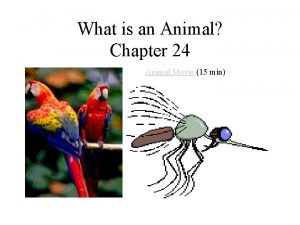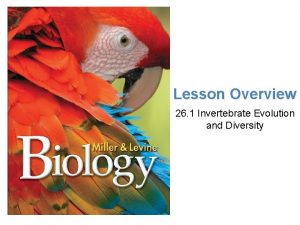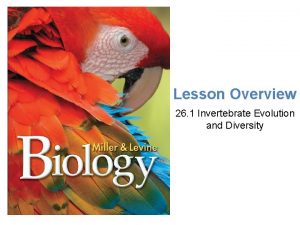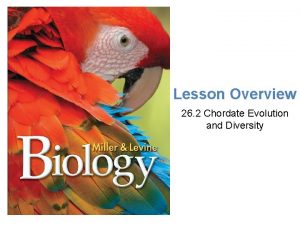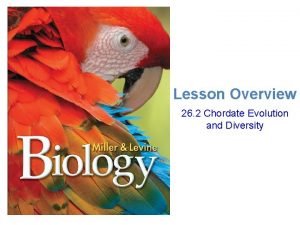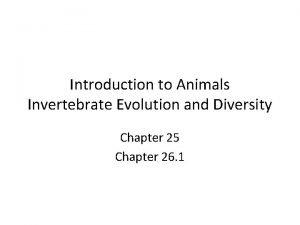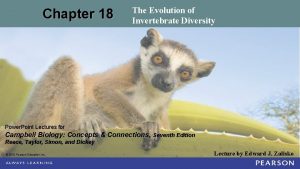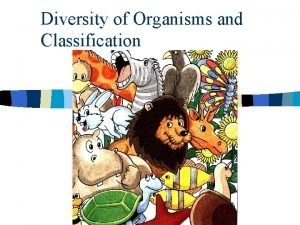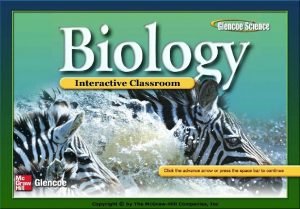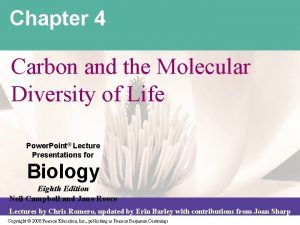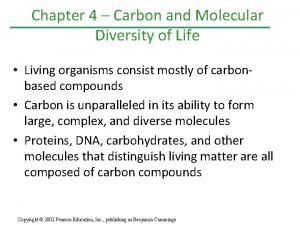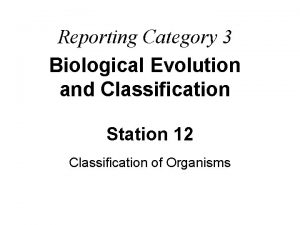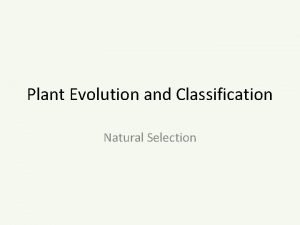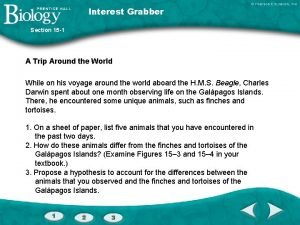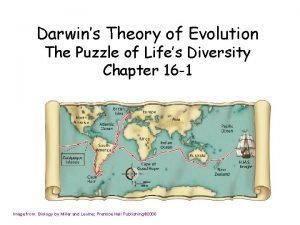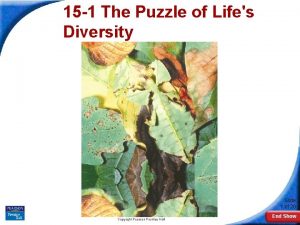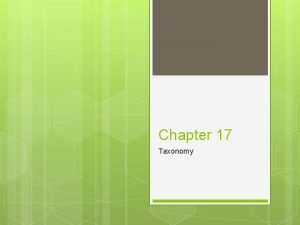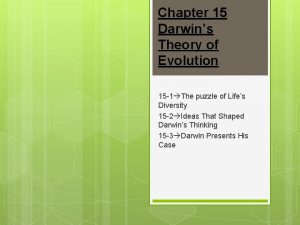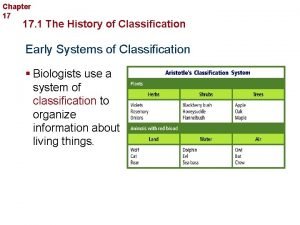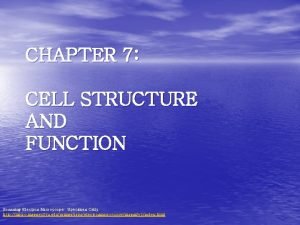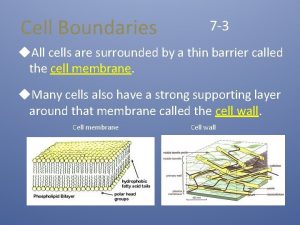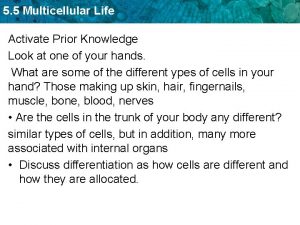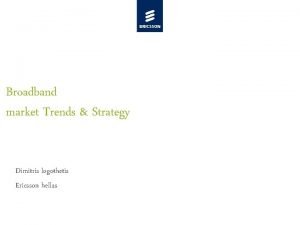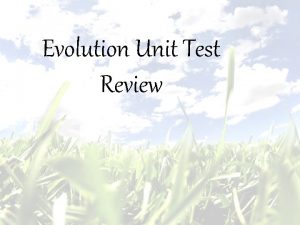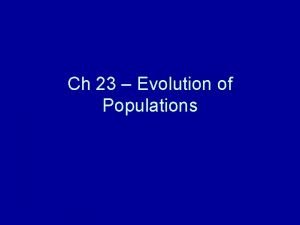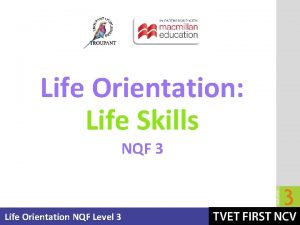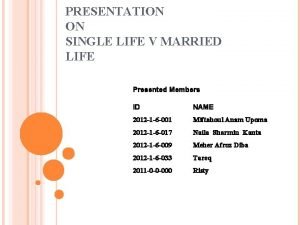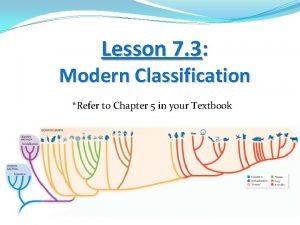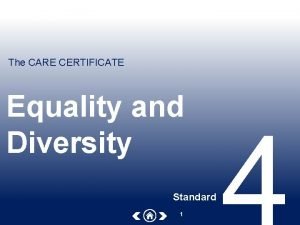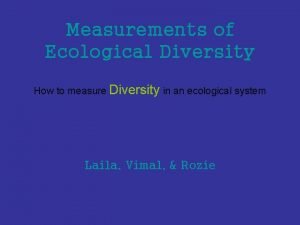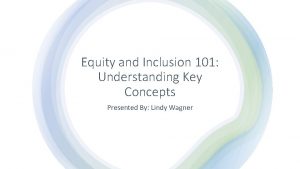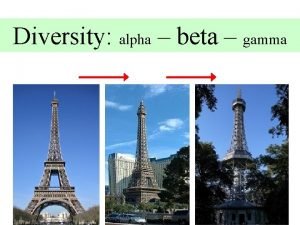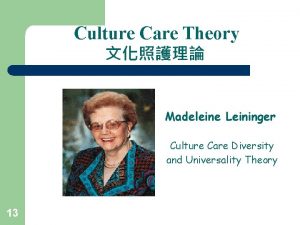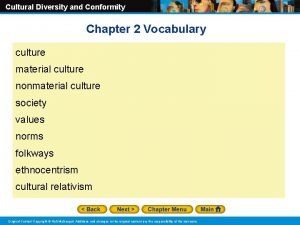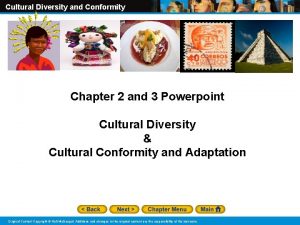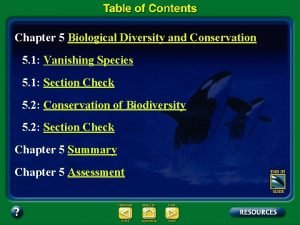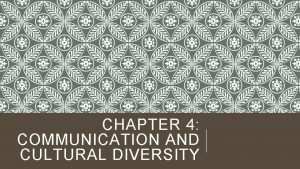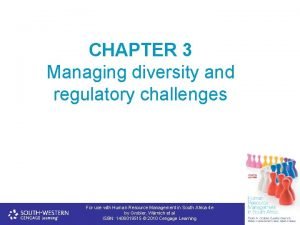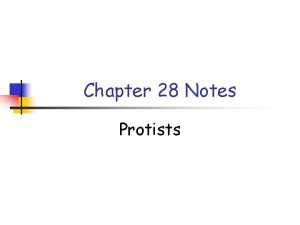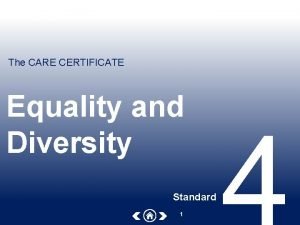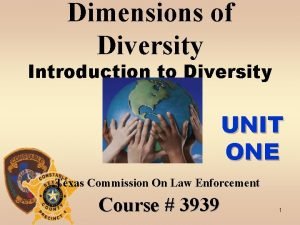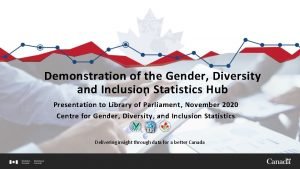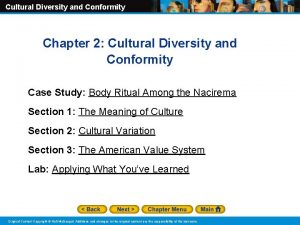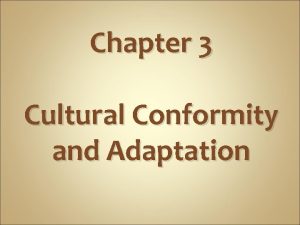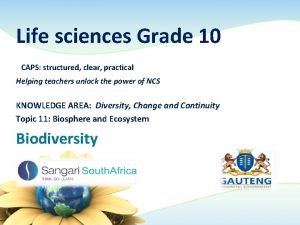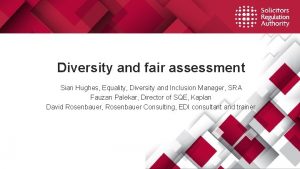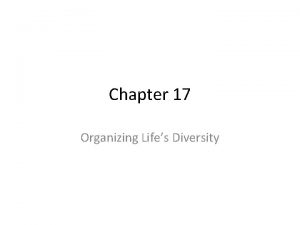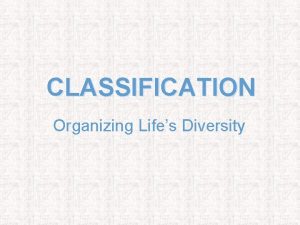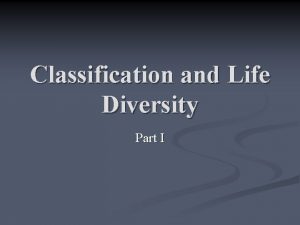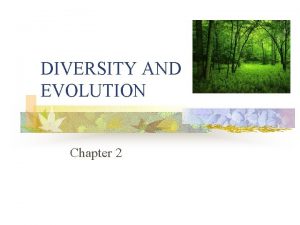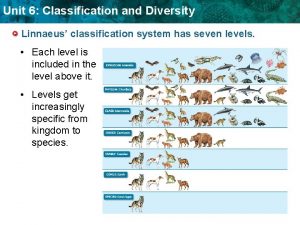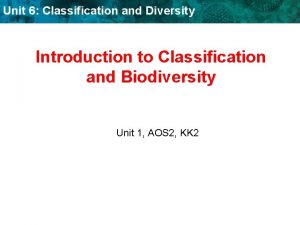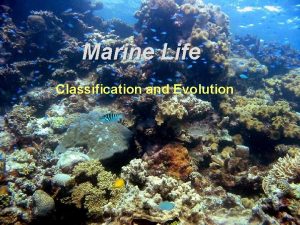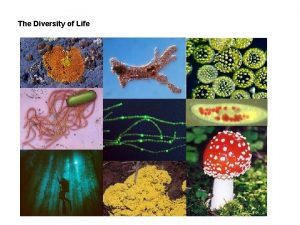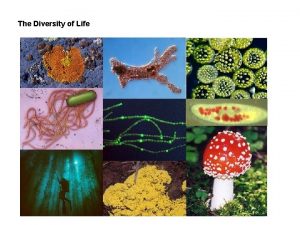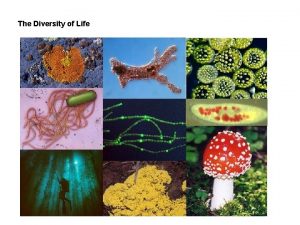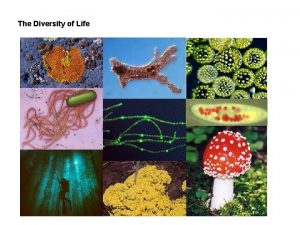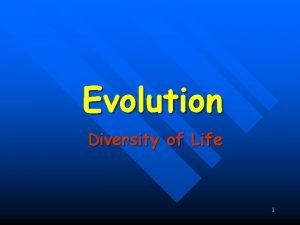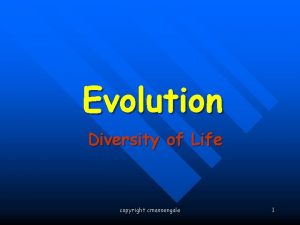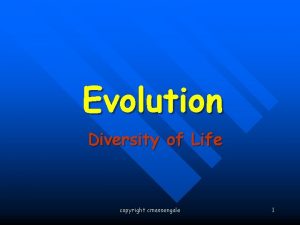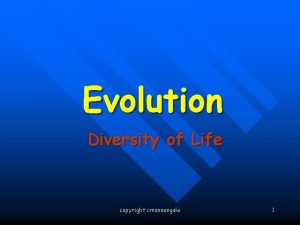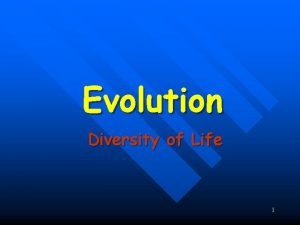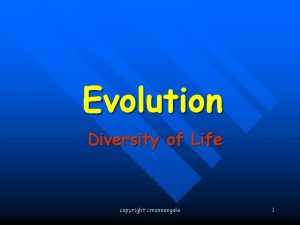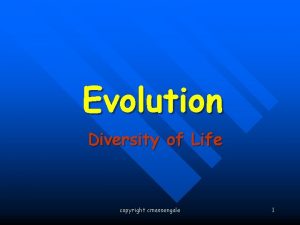Unit 4 Diversity of Life Evolution and Classification










































































- Slides: 74

Unit 4 Diversity of Life Evolution and Classification

Introduction video http: //viewpure. com/n 3265 bno 2 X 0

Charles Darwin and the Beagle -left England in 1831 -took 5 years to complete -was a volunteer naturalist position -he was 22 years old -collected plants and animals at every stop -spent much time on the Galapagos Islands making observations -noticed many variations of plants and animals from island to island

Natural Variation - differences among individuals of a species -found in all types of organisms Ex: bacterial resistance to antibiotics, cows giving different amounts of milk, fruit size

Evolution = Descent with Modification Evolution only occurs when there is a change in gene frequency within a population over time. Evolution is a long-term change. Compare these two examples of change in beetle populations. Which one is an example of evolution? 1. Beetles on a diet Imagine a year or two of drought in which there are few plants that these beetles can eat. All the beetles have the same chances of survival and reproduction, but because of food restrictions, the beetles in the population are a little smaller than the preceding generation of beetles.

2. Beetles of a different color Most of the beetles in the population (say 90%) have the genes for bright green coloration and a few of them (10%) have a gene that makes them more brown. Some number of generations later, things have changed: brown beetles are more common than they used to be and make up 70% of the population

Natural selection is one of the basic mechanisms of evolution, along with mutation, migration, and genetic drift. Darwin's grand idea of evolution by natural selection is relatively simple but often misunderstood. To find out how it works, imagine a population of beetles: Evolution by Natural Selection -many different actions are at work in order to make natural selection concept successful including: 1 There is variation in traits. For example, some beetles are green and some are brown.

OUCH! 2 There is differential reproduction. Since the environment can't support unlimited population growth, not all individuals get to reproduce to their full potential. In this example, green beetles tend to get eaten by birds and survive to reproduce less often than brown beetles do. 3 There is heredity. The surviving brown beetles have brown baby beetles because this trait has a genetic basis.

4 End result: The more advantageous trait, brown coloration, which What allows the happened to beetle to have more offspring, becomes more common in the all the green population. If this process continues, eventually, all individuals in the guys? population will be brown. If you have variation, differential reproduction, and heredity, you will have evolution by natural selection as an outcome. Survival of the Fittest- high fitness individuals live to reproduce, low fitness individuals perish.

Struggle for existence-members of each species compete regularly for food, living space An organism competes most closely with other members of its own species, because they have the most similar ecological needs to its own; other species, in decreasing order of ecological similarity, also compete and exert a negative influence on the organism's chance of survival. Interspecific Competition-members of different species competing for limiting factors Intraspecific Competition- members of the same species competing

More Modern Evidence Which Supports Theory of Evolution Embryonic Development and relative ages of evolution T I M E 1 2 3 4 5 6 7 8 Match these organisms with the numbered embryo Human, fish, salamander, turtle, chicken, pig, rabbit, calf

More Modern Evidence Which Supports Theory of Evolution Embryonic Development and relative ages of evolution 1 3 Fish 2 Salamander Tortoise 4 Chick 5 Pig 6 Calf 7 Rabbit 8 Human

Looking at embryonic development can give you a relative age as well as help you determine how closely related different organisms are. This is OLD School due to the advances in DNA analysis Who are you more closely related to? ? The Pig, the turtle, then the salamander

Even more Evidence for The THEORY of EVOLUTION Homologous Structures are of the same basic structure but used differently in the adult Humorus Ulna radius wrist Phalangies

The STRONGEST & MOST MODERN EVIDENCE which SUPPORTS the THEORY of EVOLUTION DNA

FROM A GENETIC STANDPOINT HUMANS ARE______ SIMILAR TO______ 98. 2%-Chimps 43%- Banana

SPECIATION What Is a Species? A species is a potentially interbreeding population that does not interbreed with other such populations when there is opportunity to do so. How a new species develops: It all relates to a Reproductive Isolating 1. Hybridization/Artificial Selection: When 2 different species interbreed so frequently that the resulting hybrid species will begin to intrabreed enough to sustain itself.

A NEW SPECIES? THE POLARGRIZ

2. Adaptive radiation: The formation of a number of diverse species from a single ancestral one is called an adaptive radiation. Example: Darwin’s Finches.

3. Geographic Isolation: The Kaibab squirrel became geographically isolated from the common ancestor with its closest relative, the Abert squirrel in the North Rim of the Grand Canyon about 10, 000 years ago. Since then, several distinguishing features, such as the black belly and forelimbs have gradually evolved. A geographic barrier (mountain range, river, ocean, etc. ) results in reproductive isolation and eventual changes occur in the newly separated species. Example: Grand Canyon Squirrels.

Lonesome George the last Pinta Island Giant tortoise Can you predict the different Vegetation heights on which these tortoises fed? ?

Evolution of Populations: Genetic based Gene pools- combined genetic information of all the members of a population. -typically contain 2 or more alleles for an inheritable trait coat color in labs, mice fur color 4 Sources of Genetic Variation 1 Mutations- change in the sequence of DNA -some may effect an individuals fitness (for better or worse)

2 Gene Shuffling- 23 pair of chromosomes can produce 8. 4 million combinations of genes -crossing over produces recombinants with different phenotypes -Sexual reproduction produces many phenotypes but doesn’t change frequencies

3 Single gene traits- a single gene with 2 alleles will give you 2 phenotypes (widow’s peak)

4 Polygenic traits- traits controlled by 2 or more genes -may have multiple alleles (human height, skin color) -produces many genotypes ( gene combos. ) and phenotypes (looks)

Artificial Selection- choosing the traits that we want to show up in the offspring -nature provided the variations, humans chose the ones that were useful -Selective Breeding There can be a down side to artificial selection. Because this process essentially removes variation in a population, selectively bred organisms can be especially susceptible to diseases or changes in the environment that would not be a problem for a natural population. Inbreeding — the mating of closely related individuals — is also a problem. In dogs, this has resulted in breeds that have health issues ranging from decreased life span to hip dysplasia.

What keeps Similar Species from Interbreeding to possibly result in new species? x = ? REPRODUCTIVE ISOLATION

Liger “Hercules” the Liger (12 ft. , 900 lbs. ).

Cama Due to size difference of the parents they are born through artificial insemination, and most noticeably they have no hump. Their flat backs and durability make them great pack animals.

Wolphin A rare crossbreed of a bottlenose dolphin and a false killer whale this is probably the best example of an animal that is half and half. Killer whales have 88 teeth, bottlenose dolphins have 44 teeth and the wolphin has 66 teeth.

1. STERILIZATION: The inability to reproduce due to having an uneven number of chromosomes. The Mule is a cross between a donkey stallion (called a jack) and a horse mare. Hinnies are just the opposite - a stallion horse crossed to a donkey jennet. For all purposes, hinnies and mules are classified and shown together under the general term Mule. A mule or hinny may be a male (horse mule or horse hinny) or a female (mare mule or mare hinny). Sometimes horse mules (the males) are called Johns, and the mares are called Mollies. Both male and female mules have all the correct "parts" but they are sterile and cannot reproduce. This is because horses have 64 chromosomes and donkeys have 62 chromosomes. When they create a mule it has 63 chromosomes and those chromosomes can’t be split evenly. Mule Hinny

2. MECHANICAL ISOLATION: When two different species try to reproduce but are unable to do so due to physical differences. Physical differences prevent hybridization

3. Geographic Isolation- two populations are separated by geographic barriers (rivers, mountains, oceans)

4. Temporal Isolation- two or more species reproduce at different times - some rain forest orchids open release pollen on a single day different from the others

5. Behavioral Isolation- two populations can breed but have different courtship rituals or other behaviors Western Meadowlark Eastern Meadowlark Different Mating songs

Patterns of Evolutions in Populations do Exist These Patterns of Natural Selection are best represented by graphs There are 3 basic patterns of population evolution: STABILIZING SELECTION: When the individuals in the center of the bell shaped curve have the selective advantage. The population is stable. DIRECTIONAL SELECTION: When individuals at one end on the bell-shaped curve have the selective advantage. Change is occurring in the population. DISRUPTIVE SELECTION: When individuals at the upper and lower end of the bell-shaped curve have the selective advantage. What used to be an advantage is no longer the case Toxic Newts video: http: //viewpure. com/-b. Vowxq 8 IVM

SIBERIAN HUSKY- THE ULTIMATE SLED DOG or Polar Bear Lover? NORMAL MUSCLE DEVELOPMENT “Wimpy” Muscles. TOO WEAK Mr. T Husky-TOO HEAVY STABILIZING SELECTION

BULL ELK HUNTING vs. NATURAL SELECTION Larger Bull Elk w/o Hunting SPIKES w/ Hunting Smaller Bull Elk w/o Hunting (SPIKE) DIRECTIONAL SELECTION Large Bull w/ Hunting

HIGH SCHOOL vs. “The REAL WORLD” Bill-Intellect Nuclear Engineer $145, 000/yr Mr. Former H. S. Jock H. S. Teacher $40, 000/ yr Scott-Band Member City Mayor $120, 000/yr DISRUPTIVE SELECTION

THE FOUNDER EFFECT If you are the first to survive and reproduce on the island then you are known as a FOUNDER SPECIES or PIONEER SPECIES If you are a founder species, would you expect future generations to show characteristics associated with your genes? ? (either physical, mental, or behavioral) = Red Original Population 1) New Population w/ Red Square Founder species. 2) New Population w/ similar characteristics as the original =Blue Which new population would you most expect to look like the original in a century? Population 2 3) New Population w/ Blue circle founder species.

Review How does a new species form 1. 2. 3. 4. 5. Founding of a new population Geographic Isolation Changes in the gene pool Reproductive Isolation Geographic Overlap

Evolution is a THEORY which describes how organisms change over time. CHARLES DARWIN is considered the father of evolutionary theory. Most of Darwin’s ideas came from his observations of the organisms living on the GALAPOGOS ISLANDS.

Darwin published his now famous book “ON THE ORIGIN OF SPECIES” 25 years after his return from the Galapagos Islands DARWIN’s ideas included: -NATURAL VARIATION: Individual organisms in nature differ from one another. (Physical & Genetics) Red Fox

-Organisms will produce more OFFSPRING than will SURVIVE

-Members of each species COMPETE for RESOURCES

Due to VARIATION between individuals, some have ADVANTAGES while others are at a DISADVANTAGE. This is the concept of NATURAL SELECTION.

-Individuals best suited to the environment SURVIVE, breed, and pass on their genes to the next generation -Those unsuited die, or leave fewer young. This is the concept of SURVIVAL of THE FITTEST -Species change over time due to NATURAL SELECTION. Over time new species arise and some go EXTINCT -Species alive today have DESCENDED from species from the PAST -So all species alive today have descended from forms of LIFE from the past. This is EVOLUTION or DESCENT with MODIFICATION

SUPPORTING EVIDENCE for Darwin’s Theory: -FOSSIL RECORDS suggest changes in a organism over time. Learning From the Fossil Record

Species in different countries that develop similar characteristics due to similar habitats is GEOGRAPHIC DISTRIBUTION OF LIVING SPECIES.

Structures, which develop from the same embryonic tissue, but change into different useful forms in the adult are HOMOLOGOUS BODY STRUCTURES

-Embryos of different animals that develop the same way of suggesting similar ancestors are called EMBRYONIC DEVELOPMENT.

-DNA ANALYSIS is used to show closely related two or more different species are.

The moral of the story is that if you can not adapt to changes in your Environment then you will get out competed & die or not reproduce.

You have encountered this animal while backpacking in the Idaho wilderness. What is it?

Is it the same animal as these? How do you know?

What is its name? Common Names Mountain lion, Puma, Cougar, Painter, Catamount, Panther

Felis concolor

Taxonomy- the science of naming organisms and placing them into groups To avoid confusion scientific names are used whenever possible when describing organisms Good Try! - the first efforts of grouping organisms was a very lengthy descriptive process "Oak with deeply divided leaves that have no hairs on their undersides and no teeth around their edges" (Quercus palustris) Pin Oak

Introducing: Carolus Linnaeus -Father of Taxonomy -Highly acclaimed Botanist and Ecologist - Swedish -Invented Binomial Nomenclature 1707 -1778 100 Kroner (Sweden) Carl von Linne coat of arms

Binomial Nomenclature- each species is assigned a two part name - always written in italics - first word is always CAPITALIZED (Genus) - second word is always lower case (Species) Pseudotsuga menziesii Artemesia tridentata (Genus) (species) Pinus ponderosa

Bear Family Members The bear family includes eight species: the polar bear, American black bear, spectacled bear, giant panda, sloth bear, sun bear, brown bear, and Asiatic black bear. Ursus americanus Ursus arctos

Ailuropoda melanoleuca *has it's own genus and species *it is highly specialized Ursus maritimus

How are you classified? How do you remember the order? King Phillip Cried Oh For Goodness Sake or Kings Play Chess On Fridays Generally Speaking or King Phillip Came Over From Germany Saturday Kingdom- Animalia Phylum- Chordata- have notochords Subphylum- Vertebrata- vertebral column Superclass- Tetrapoda- terrestrial, 4 limbs, bony skeletons Class- Mammalia- hair, milk glands, endothermic Subclass- Eutheria- offspring develop within mother, nourished by placenta Order- Primata- fingers, flat nails Family- Hominidae- upright posture, flat face, stereoscopic vision, large brain, hands and feet Genus- Homo- double curved spine, long life, long youth Species- sapiens -well-developed chin, high forehead, thin skull bones Which 2 species would be more closely related? Canis lupus Ursus arctos Canis domesticus

SIX KINGDOMS of LIFE

SIX KINGDOMS of LIFE Kingdom When Evolved Structure Photosynthesis 1. Bacteria 3 to 4 billion years ago Unicellular Sometimes 2. Archaea 3 to 4 billion years ago Unicellular No 3. Protista 1. 5 billion years ago Unicellular Sometimes 4. Fungi 1 billion years ago Unicellular or Multicellular No 5. Animalia 700 million years ago Multicellular No 6. Plantae 500 million years ago Multicellular Yes Prokaryotes: - No Nucleus Eukaryotes: - True Nucleus Plants Animals Kingdom Archeabacteria Kingdom Eubacteria Kingdom Protista Kingdom Fungi



Bacteria Archaea Eukarya Archae Eubacteria Protista Fungi Plantae Animalia bacteria Prokaryote Pro. Eukaryote Euk- Eukwithout Unicellular Uni. Autotroph Autoheterotroph Hetero- Multicell ular Multi. Auto. Hetero- Auto- Hetero-

Eukaryote vs. Prokaryote Eukaryotic organisms have a TRUE Nucleus Prokaryotic organisms have DNA or RNA But it is NOT contained in a nucleus

Variations to the Classification System Botanists use a division instead of phylum The species level can be further divided: -Animals can be divided into subspecies(ssp. )- morphologically different and often geographically separated (see following slide) -Fruits (plants) are divided into different varieties(var. )morphologically different but not geographically separated, some produced by humans (see following slide) -Bacteria are divided into different strains(str. )- biochemically dissimilar group within a species Example: E coli

Royal Gala Honeygold Jonagold Golden delicious Braeburn Fugi Malus domestica Pink Lady

Map of Wolf subspecies of North America Canis lupus tundrarum (Tundra wolf) Canis lupus arctos (Arctic wolf) Canis lupus baileyi (Mexican wolf) Canis lupus crassodon (Vancouver Island wolf)

Virus’s • How do virus’s fit? – Non-classifiable. They aren’t made of cells. • Are they alive? – No. They need a host in order to survive. • Do they meet the requirements of living organisms? – No. They are not made of cells nor are they living.

 Chapter 24 animal evolution diversity and behavior
Chapter 24 animal evolution diversity and behavior Lesson 5 invertebrate evolution and diversity 2
Lesson 5 invertebrate evolution and diversity 2 What does the cladogram of invertebrates illustrate?
What does the cladogram of invertebrates illustrate? Diversity of chordate
Diversity of chordate Lesson 6: chordate evolution and diversity
Lesson 6: chordate evolution and diversity Cladogram of invertebrates
Cladogram of invertebrates Genetic diversity vs species diversity
Genetic diversity vs species diversity Genetic diversity vs species diversity
Genetic diversity vs species diversity Chapter 18 the evolution of invertebrate diversity
Chapter 18 the evolution of invertebrate diversity Freetutorical.com harvest land
Freetutorical.com harvest land Diversity and classification
Diversity and classification Diversity and interdependence of life
Diversity and interdependence of life Organizing life's diversity
Organizing life's diversity Biodiversity and conservation
Biodiversity and conservation Carbon and the molecular diversity of life
Carbon and the molecular diversity of life Chapter 4 carbon and the molecular diversity of life
Chapter 4 carbon and the molecular diversity of life Unit 2: equality and diversity in the community
Unit 2: equality and diversity in the community Care value base health and social care
Care value base health and social care Category 3 biological evolution and classification
Category 3 biological evolution and classification Bryophyta hepatophyta anthocerophyta
Bryophyta hepatophyta anthocerophyta Unit 10, unit 10 review tests, unit 10 general test
Unit 10, unit 10 review tests, unit 10 general test Section 15-1 the puzzle of life's diversity answers
Section 15-1 the puzzle of life's diversity answers Section 15-1 the puzzle of life's diversity answer key
Section 15-1 the puzzle of life's diversity answer key 15-1 the puzzle of life's diversity
15-1 the puzzle of life's diversity Organizing life's diversity
Organizing life's diversity Section 15-1 the puzzle of life's diversity answer key
Section 15-1 the puzzle of life's diversity answer key Organizing life's diversity
Organizing life's diversity Section 7-4 the diversity of cellular life
Section 7-4 the diversity of cellular life Section 7-4 the diversity of cellular life
Section 7-4 the diversity of cellular life Unit 1 diversity in the living world
Unit 1 diversity in the living world Life expectancy evolution
Life expectancy evolution Section 17-3 evolution of multicellular life
Section 17-3 evolution of multicellular life Life expectancy evolution
Life expectancy evolution Section 17-3 evolution of multicellular life answer key
Section 17-3 evolution of multicellular life answer key Stellar evolution lab the life cycle of a star
Stellar evolution lab the life cycle of a star My intuition is telling me there be better days
My intuition is telling me there be better days Ericsson hellas
Ericsson hellas Evolution unit test
Evolution unit test Unit 10 evolution test answers
Unit 10 evolution test answers Why are populations the smallest unit of evolution
Why are populations the smallest unit of evolution Manifold classification in statistics example
Manifold classification in statistics example Chapter 5 diversity and human needs and development
Chapter 5 diversity and human needs and development Living things grow
Living things grow Vocabulary city life
Vocabulary city life Difference between life skills and life orientation
Difference between life skills and life orientation Off marriage and single life
Off marriage and single life Hyp opp adj triangle
Hyp opp adj triangle Unit process and unit operation
Unit process and unit operation Unit operation and unit process
Unit operation and unit process Eager vs lazy
Eager vs lazy Traditional classification vs modern classification
Traditional classification vs modern classification Types of workplace diversity
Types of workplace diversity Care certificate equality and diversity
Care certificate equality and diversity Nature nurture and human diversity
Nature nurture and human diversity Ecological diversity is a measure of the number of
Ecological diversity is a measure of the number of Diversity, equity and inclusion 101
Diversity, equity and inclusion 101 Diversity and inclusion scorecard
Diversity and inclusion scorecard Alpha beta gamma diversity
Alpha beta gamma diversity Madeleine leininger sunrise model
Madeleine leininger sunrise model Cultural diversity and conformity section 3
Cultural diversity and conformity section 3 Cultural diversity and conformity guided reading section 3
Cultural diversity and conformity guided reading section 3 Chapter 8 study guide human resources culture and diversity
Chapter 8 study guide human resources culture and diversity Chapter 8 study guide human resources culture and diversity
Chapter 8 study guide human resources culture and diversity Chapter 5 biological diversity and conservation
Chapter 5 biological diversity and conservation Chapter 4 communication and cultural diversity
Chapter 4 communication and cultural diversity Managing diversity and regulatory challenges
Managing diversity and regulatory challenges Structural and functional diversity in protists
Structural and functional diversity in protists Care certificate standard 4
Care certificate standard 4 The three dimensions of global inclusion are
The three dimensions of global inclusion are Centre for gender diversity and inclusion statistics
Centre for gender diversity and inclusion statistics Sociology chapter 2: cultural diversity and conformity
Sociology chapter 2: cultural diversity and conformity Worldwide accounting diversity and international standards
Worldwide accounting diversity and international standards Cultural diversity and conformity chapter test form a
Cultural diversity and conformity chapter test form a Diversity change and continuity grade 10
Diversity change and continuity grade 10 Diversity and inclusion consulting
Diversity and inclusion consulting
